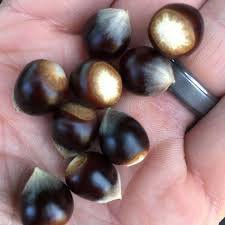Since 2010, Hobbs State Park has been working closely with the Ozark Chinquapin Foundation in the effort to save a "keystone" tree, the Ozark Chinquapin.
For years, Hobbs State Park has sent what seed it could find to the OCF. Hobbs State Park was then the first to be successful in cross-pollinating an Ozark Chinquapin tree with pollen from trees from Mississippi, Missouri, Texas and Arkansas. The next step was to establish an Ozark Chinquapin test plot at Hobbs State Park. The first plantings were done at Hobbs in April of 2014.
One of the keys to saving this tree is to find single-trunked, seed-producing Ozark Chinquapins. The public's help is requested in this effort. If you think you know of a healthy, single-trunked Ozark Chinquapin tree, please contact Steve Chyrchel at Hobbs State Park with that information.
Another key to saving the Ozark Chinquapins is through important leaf research that the Ozark Chinquapin Foundation recently began at the laboratories of the Missouri Botanical Garden. Leslie Bost, who is conducting the research, was contacted for an update. Bost replied, "Research is progressing, and I am indeed finding some very significant data. We have some special resistant trees on our plots. Our most resistant tree is one we originally thought was low resistance."
This exciting research identifies in a few days which trees are the most blight resistant. Culling trees from our test plots that show the least resistance to the blight, and leaving the ones with the highest resistance, saves years in producing blight-resistant seed that can be successfully reintroduced into the native range of the Ozark Chinquapin.
To be successful, more individuals are needed who are knowledgeable of the Ozark Chinquapin, what it meant to wildlife before the Chestnut blight hit the region in 1957, and what the Ozark Chinquapin Foundation and state parks in Arkansas and Missouri are doing to help save this tree.
• If you know of a healthy, single-trunked Ozark Chinquapin tree, please share that information with Steve Chyrchel board member of the Ozark Chinquapin Foundation and Interpreter at Hobbs State Park-Conservation Area at the following address: Steve Chyrchel, Interpreter, Hobbs State Park-Conservation Area, 20201 E. Highway 12, Rogers, AR 72756, 479-789-5006, or email [email protected].
• Please take some time to learn more about the Ozark Chinquapin tree. The Ozark Chinquapin Foundation has a wonderful website. Check out all the links at the top of the page located at www.ozarkchinquapinmembership.org.
• National Geographic just published an article on the efforts to save this tree: June 24, 2019. It can be viewed at www.nationalgeographic.com/environment/2019/06/saving-chestnut-trees-ozarks.
General News on 08/21/2019
